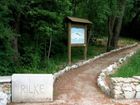
Climbing
Le numerose falesie della costiera triestina, oltre alla famosa Val Rosandra e Napoleonica, offrono agli appassionati pareti attrezzate per l’arrampicata sportiva con gradi di difficoltà crescenti fino 8a (scala UIAA) riuscendo a soddisfare tutti, dai principianti ai grandi esperti.
La Direzione sarà lieta di darti tutte le informazioni per raggiungere i siti più belli: dalle falesie a picco sul mare alle pareti della Val Rosandra, nel cuore di una delle più belle Riserve naturali della Regione Friuli Venezia Giulia.
Nel nostro sito puoi trovare alcune schede tecniche, come suggerimento per organizzare una vacanza dedicata al tuo sport preferito!
EN:
Climbing
The many cliffs of the coast of Trieste and also the famous Val Rosandra and Napoleonic, offer to passionate people equipped walls for climbing with increasing levels of difficulty until 8a (UIAA scale) managing to satisfy everyone, from beginners to great experts.
The management will be glad to give you all the information to reach the most beautiful sites: from the cliffs overlooking the sea or on the walls of Val Rosandra, in the heart of one of the most beautiful nature reserves of the Region Friuli Venezia Giulia.
On our website you can find some datasheets, as a suggestion to organize a holiday dedicated to your favourite sport!
DE:
Klettern
Zahlreiche Kletterwände entlang der Triester Küste und in dem berühmten Rosandra Tal – Val Rosandra und Napoleonica, bieten viele Möglichkeiten von Kletternrouten mit verschiedenen Schwierigkeitsgraden bis zum 8a Grad (UIAA Bewertungssystem) an, um sowohl Anfänger als auch Experten zufrieden zu stellen.
Am Rezeption werden Sie von der Direktion alle Informationen bekommen, um die beste Orte zu erreichen: von den Kliffen von Duino bis zu den Kletterwänden im Rosandra Tal - Val Rosandra, im Herzen einer der schönsten Naturschutzgebiete der Region Friaul-Julisch Venetien.
Auf unserer Webseite können Sie einige technische Datenblätter zum Klettern finden, als Empfehlung für einen Urlaub mit Fokus auf ihren Lieblingssport!

Museo all’aperto di Monte Ermada
A pochi chilometri dal campeggio si trova il Museo all'aperto del Monte Ermada che offre la possibilità di scoprire la linea difensiva austro-ungarica fortificata nel settembre del 1916 dopo la Sesta Battaglia dell'Isonzo. Si tratta di un itinerario immerso nella natura del Carso triestino ed è composto da due anelli visitabili separatamente oppure in un'unica giornata.
EN:
Open-air museum
A few kilometers from the campsite is the open-air Museum of Mount Ermada that offers the opportunity to discover the Austro-Hungarian fortified defensive line in September of 1916 after the Sixth Battle of the Isonzo. It is a route immersed in the nature of the Carso and is composed of two rings which can be visited separately or in a single day.
DE:
Freilichtmuseum Monte Hermada
Wenige km vom Camping entfernt ist das Freilichtmuseum Monte Hermada, das uns die Möglichkeit gibt, die Spuren der im September 1916, nach der sogenannten „6. Isonzoschlacht“, befestigten österreichisch-ungarischen Verteidigungslinie zu entdecken. Es ist eine Wanderroute in der Natur des Triester Karstes, die aus zwei Rundgängen besteht. Diese können getrennt oder an einem einzigen Tag besucht werden.

Sentiero Rilke
Tra Sistiana e Duino, lungo la fascia costiera, si trova la Riserva naturale delle falesie di Duino che può essere attraversta in gran parte seguendo il panoramico “Sentiero Rilke”, così chiamato in onore del poeta tedesco Rainer Maria Rilke che qui passeggiava abitualmente durante il suo soggiorno al Castello di Duino (1911-12), ospite della principessa Maria della Torre e Tasso.
EN:
Rilke path
Between Sistiana and Duino, along the coast, lies the nature reserve of the cliffs of Duino which can be crossed over largely following the panoramic "Rilke Path", named after the German poet Rainer Maria Rilke who was usually walking on the cliffs during his stay at the Castello di Duino (1911-12), guest of Princess Maria della Torre e Tasso.
DE :
Rilke Weg
Zwischen Sistiana und Duino, entlang der Küste, befindet sich das Naturschutzgebiet der Kliffen von Duino, wo man den panoramischen „Rilkeweg“ folgen kann; dieser Wanderweg ist nach Rainer Maria Rilke benannt. Der deutschsprachige Dichter ist hier spazieren gegangen, als er im Schloss Duino (1911-12) zu Gast bei der Prinzessin Marie von Thurm und Taxis war.

Gemina
Gemina è un tracciato sterrato che dalla piazza di Malchina conduce al centro di Sgonico, passando anche per le graziose località di San Pelagio e Prepotto. L’itinerario si sviluppa sfruttando alcune strade poderali utilizzate un tempo come vie secondarie e di servizio per le attività agricole e pastorali. Il tracciato è stato così chiamato per omaggiare la strada romana che congiungeva Aquileia a Trieste. “Gemina” deriva con buona probabilità dal nome della XIII Legione, che costruì questo tratto viario, allora necessario a collegare l’impero romano con Lubiana.
EN:
Gemina
Gemina is a dirt track that from the square of Malchina leads to the centre of Sgonico, passing also the pretty places of San Pelagio and Prepotto. The itinerary is developed taking advantage of some farm roads used in the past as secondary roads and roads for services of agricultural and pastoral activities.
The track is named Gemina to honour the old roman street that connected Aquileia to Trieste.
“Gemina” "comes in all probability from the XIII Legion name, who built this stretch of road, because it was necessary to link the Roman Empire with Ljubljana.
DE:
Geminaweg
Es ist ein Weg, der von der Piazza von Malchina durch die schönen Dörfer von San Pelagio und Prepotto bis ins Zentrum von Sgonico führt. Die Route verläuft über einige Gutsstraßen, die in der Vergangenheit von Landarbeitern und Hirten genutzt wurden. Der Weg wurde so genannt, um an die altrömische Straße Gemina, die Aquileia mit Triest verband, zu erinnern.
„Gemina“ war die Legio XIII Gemina (13. Zwillingslegion), eine Legion der römischen Armee, die wahrscheinlich diese Straße baute, um das Gebiet des Römischen Kaiserreichs mit Ljubliana zu verbinden.




